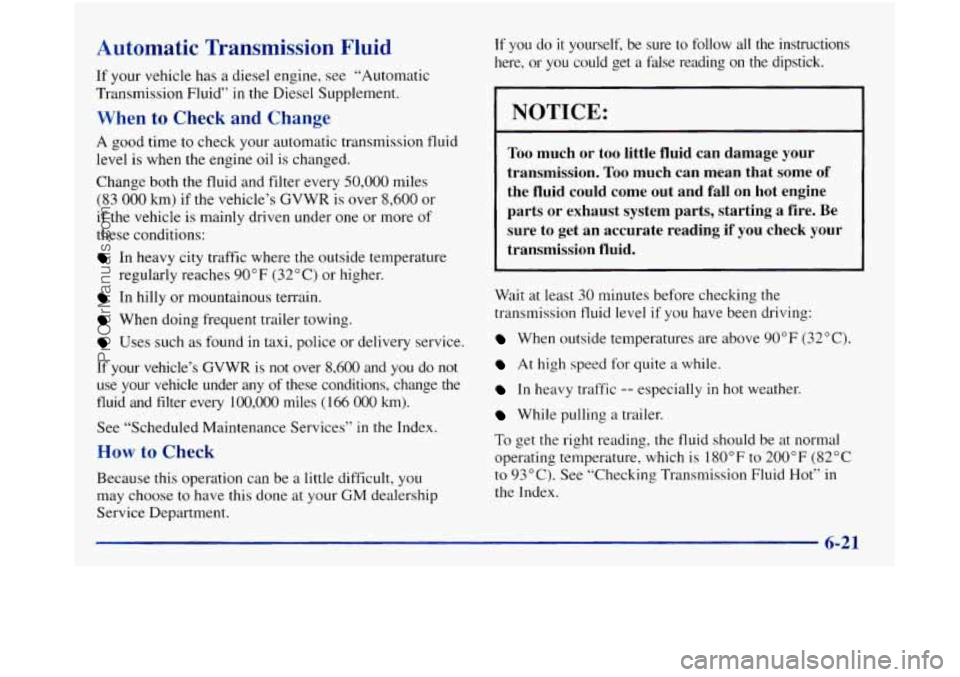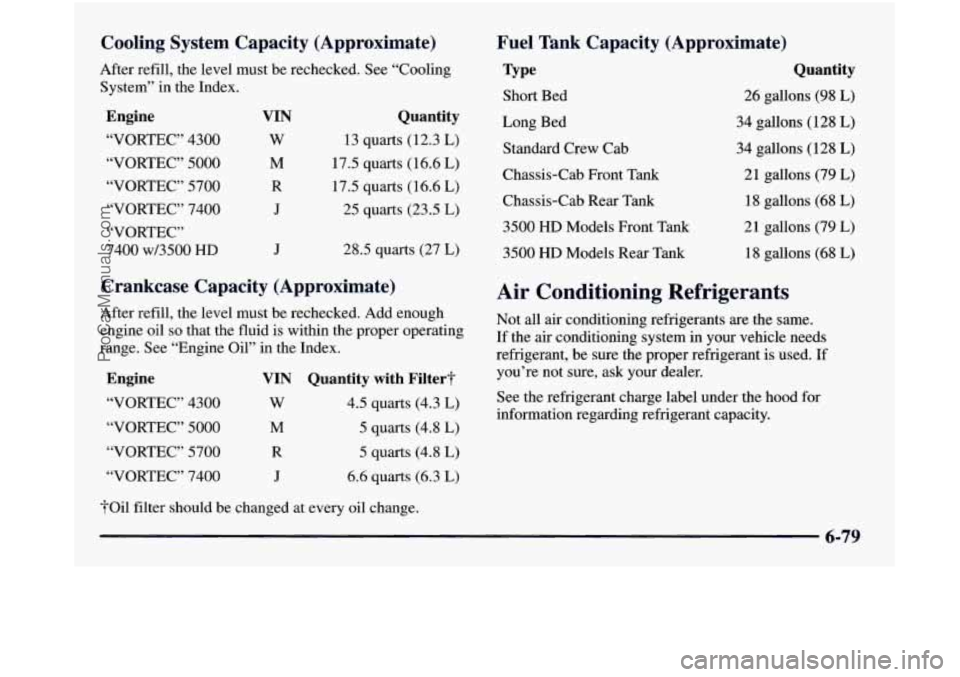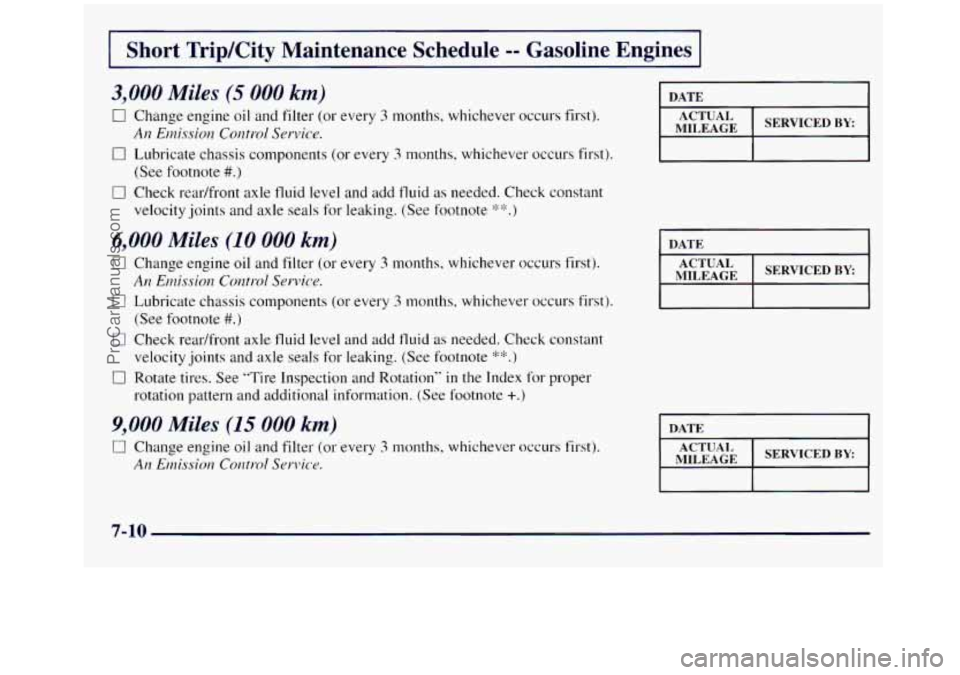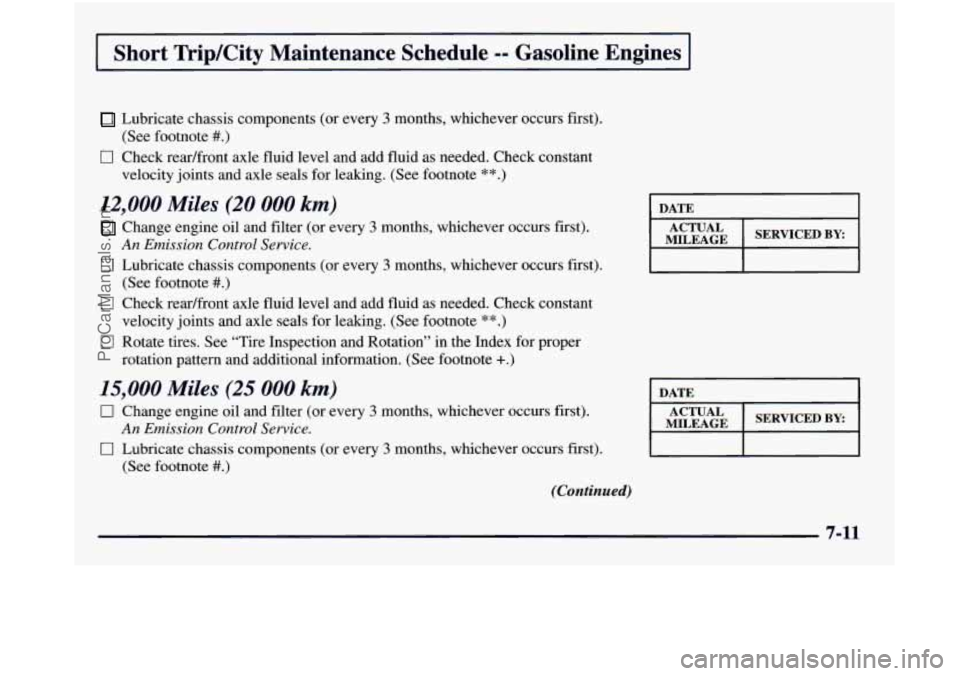Page 304 of 452
Engine Oil (Gasoline Engine)
If your vehicle has a diesel engine, see “Engine Oil
(Diesel Engine)” in the Diesel Engine Supplement.
It’s
a good idea to check your engine oil every time you
get fuel. In order to get an accurate reading, the
oil must
be warm and the vehicle
must be on level ground.
.. ..
The engine oil dipstick has a yellow ring handle and is
located
on the passenger’s side of the engine.
Turn
off the engine and give the oil a few minutes to
drain back into
the oil pan. If you don’t, the oil dipstick
might not show the actual
level.
Checking Engine Oil
Pull out the dipstick and clean it with a paper towel or
cloth, then push it back in all the way. Remove it again,
keeping the tip down, and check the level.
u
6-14
ProCarManuals.com
Page 311 of 452

Automatic Transmission Fluid
If your vehicle has a diesel engine, see “Automatic
Transmission Fluid”
in the Diesel Supplement.
When to Check and Change
A good time to check your automatic transmission fluid
level is when the engine oil is changed.
Change both the fluid and filter every
50,000 miles
(83
000 km) if the vehicle’s GVWR is over 8,600 or
if the vehicle is mainly driven under one or more of
these conditions:
In heavy city traffic where the outside temperature
In hilly or mountainous terrain.
When doing frequent trailer towing.
Uses such as found in taxi, police or delivery service.
regularly
reaches
90°F (32°C) or higher.
If your vehicle’s GVWR is not over 8,600 and you do not
use your vehicle under any
of these conditions, change the
fluid and filter every
100,000 miles (166 000 km).
See “Scheduled Maintenance Services’’ in the Index.
How to Check
Because this operation can be a little difficult, you
may choose to have this done at your
GM dealership
Service Department.
If you do it yourself, be sure to follow all the instructions
here, or you could get a false reading on the dipstick.
NOTICE:
Too much or too little fluid can damage your
transmission.
Too much can mean that some of
the fluid could come
out and fall on hot engine
parts or exhaust system parts, starting a fire.
Be
sure to get an accurate reading if you check your
transmission fluid.
Wait at least 30 minutes before checking the
transmission fluid level if you have been driving:
When outside temperatures are above 90°F (32°C).
At high speed for quite a while.
In heavy traffic -- especially in hot weather.
While pulling a trailer.
To get the right reading, the fluid should be at normal
operating temperature, which is
180°F to 200°F (82°C
to 93°C). See “Checking Transmission Fluid Hot“ in
the Index.
6-21
ProCarManuals.com
Page 314 of 452

Manual Transmission Fluid
When to Check
A good time to have it checked is when the engine oil is
changed. However, the fluid in your manual
transmission doesn’t require changing.
How to Check
Because this operation can be a little difficult, you
may choose to have this done at your GM dealership
Service Department.
If you do it yourself, be sure to follow all the
instructions here, or you could get a fdse reading.
NOTICE:
Too much or too little fluid can damage your
transmission.
Too much can mean that some of
the fluid could come out and fall on hot engine
parts or exhaust system parts, starting a fire. Be
sure to get an accurate reading if you check your
transmission fluid.
Check the fluid level only when your engine is off, the
vehicle is parked on a level place and the transmission is
cool enough
for you to rest your fingers on the
transmission case.
Then, follow these steps:
I. Remove the filler plug.
2. Check that the lubricant level is up to the bottom of
the filler plug hole.
3. If the fluid level is good, install the plug and be sure
it is fully seated. If the fluid level is low, add more
fluid as described in the next steps.
6-24
ProCarManuals.com
Page 318 of 452

How to Check Lubricant
If the level is below the bottom of the filler plug hole,
you may need to add some lubricant.
When the differential is cold, add enough lubricant to
raise the level to 1/2 inch (12
mrn) below the filler
plug hole.
When the differential is at operating temperature
(warm), add enough lubricant to raise the level to the
bottom
of the filler plug hole.
What to Use
Refer to the Maintenance Schedule to determine what
kind of lubricant to use. See “Recommended Fluids and
Lubricants” in the Index.
Engine Coolant
The cooling s stem in your vehicle is filled with
DEX-COOL engine coolant. This coolant is designed
~
to remain in your vehicle for 5 years or 150,000 miles I
(240 000 km) whichever occurs first, if you add only ~
DEX-COOL’ extended life coolant.
8
The following explains your cooling system and how
to add coolant when it is low. If you have a problem
i
with engine overheating, see “Engine Overheating” in 1
the Index.
A 50/50 mixture of water and DEX-COOL@ coolant will: 1
0 Give freezing protection down to -34°F (-37°C).
0 Give boiling protection up to 265 OF (1 29 O C).
Protect against rust and corrosion.
0 Help keep the proper engine temperature.
0 Let the warning gages work as they should.
6-28 ;L
ProCarManuals.com
Page 369 of 452

Cooling System Capacity (Approximate)
After refill, the level must be rechecked. See “Cooling
System” in the Index.
Engine
“VORTEC” 4300
“VORTEC” 5000
“VORTEC” 5700
“VORTEC” 7400
“VORTEC”
7400 w/3500 HD
VLN
w
M
R
J
J
Quantity
13 quarts (12.3 L)
17.5 quarts (16.6 L)
17.5 quarts (16.6
L)
25 quarts (23.5 L)
28.5 quarts (27
L)
Crankcase Capacity (Approximate)
After refill, the level must be rechecked. Add enough
engine oil
so that the fluid is within the proper operating
range. See “Engine Oil” in the Index.
Engine
“VORTEC” 4300
“VORTEC” 5000
“VORTEC” 5700
“VORTEC” 7400
VIN Quantity with Filter?
w 4.5 quarts (4.3 L)
M 5 quarts (4.8 L)
R 5 quarts (4.8 L)
J 6.6 quarts (6.3 L)
foil filter should be changed at every oil change.
Fuel Tank Capacity (Approximate)
PPe Quantity
Short Bed
26 gallons (98 L)
Long Bed
34 gallons (128
L)
Standard Crew Cab 34 gallons (128 L)
Chassis-Cab Front Tank 2 1 gallons (79 L)
Chassis-Cab Rear Tank
18 gallons (68
L)
3500 HD Models Front Tank
21 gallons (79 L)
3500 HD Models Rear Tank
18 gallons (68
L)
Air Conditioning Refrigerants
Not all air conditioning refrigerants are the same.
If the air conditioning system in your vehicle needs
refrigerant, be sure the proper refrigerant is used. If
you’re not sure, ask your dealer.
See the refrigerant charge label under the
hood for
information regarding refrigerant capacity.
6-79
ProCarManuals.com
Page 379 of 452

1 Short Trip/City Maintenance Schedule -- Gasoline Engines I
4:::: Drive axle service (see "Recommended Fluids and
Lubricants"
in the Index for proper lubricant to use):
0 Locking Differential -- Drain fluid and refill at first
engine oil change. At subsequent oil changes, check
fluid level and add fluid as needed.
If driving in
dusty areas or towing a trailer, drain fluid and refill
every
15,000 miles (25 000 km).
Standard Differential -- Check fluid level and add
fluid as needed at every oil change.
If driving in
dusty areas or towing a trailer. drain fluid and refill
every 15,000 miles (25
000 km).
More frequent lubrication may be required for
0 3500 HD Models with applications requiring
heavy-duty
or off-road use.
extreme overload/trailer towing conditions and
high-speed (above
45 mph or 70 km/h) conditions
for extended periods of time must have the drive axle
fluid changed every
30,000 miles (50 000 km).
See "Recommended Fluids and Lubricants" in
this section.
7-9
ProCarManuals.com
Page 380 of 452

I Short TripKity Maintenance Schedule -- Gasoline Engines I
3,000 Miles (5 000 km)
Ci Change engine oil and filter (or every 3 months, whichever occurs first).
0 Lubricate chassis components (or every 3 months, whichever occurs first).
0 Check readfront axle fluid level and add fluid as needed. Check constant
An Etnission Comd Service.
(See footnote #.)
velocity joints and axle seals for leaking. (See footnote $'*.)
6,000 Miles (10 000 km)
Cl Change engine oil and filter (or every 3 months, whichever occurs first).
0 Lubricate chassis components (or every 3 months, whichever occurs first).
0 Check readfront axle fluid level and add fluid as needed. Check constant
0 Rotate tires. See "Tire Inspection and Rotation" in the Index for proper
An Emission Colztr-ol Service.
(See footnote #.)
velocity joints and axle seals for leaking. (See footnote **.)
rotation pattern and additional information. (See footnote +.)
9,000 Miles (15 000 km)
0 Change engine oil and filter (or every 3 months, whichever occurs first).
An EInisston Control Service.
I DATE I
I MILEAGE ACT I SERVICEDBY I
DATE
MILEAGE
DATE I
SERVICED BY
7-10
ProCarManuals.com
Page 381 of 452

I Short TripKity Maintenance Schedule -- Gasoline Engines I
Lubricate chassis components (or every 3 months, whichever occurs first).
0 Check readfront axle fluid level and add fluid as needed. Check constant
(See footnote
#.)
velocity
joints and axle seals for leaking. (See footnote **.)
12,000 Miles (20 000 km)
Change engine oil and filter (or every 3 months, whichever occurs first).
An Emission Control Service.
0 Lubricate chassis components (or every 3 months, whichever occurs first).
17 Check readfront axle fluid level and add fluid as needed. Check constant
0 Rotate tires. See “Tire Inspection and Rotation” in the Index for proper
(See
footnote
#.)
velocity joints and axle seals for leaking. (See footnote **.)
rotation pattern and additional information. (See footnote +.)
15,000 Miles (25 000 km)
0 Change engine oil and filter (or every 3 months, whichever occurs first).
17 Lubricate chassis components (or every 3 months, whichever occurs first).
An Emission Control Service.
(See footnote #.)
(Continued)
DATE 1
DATE 1
ACTUAL
7-11
ProCarManuals.com